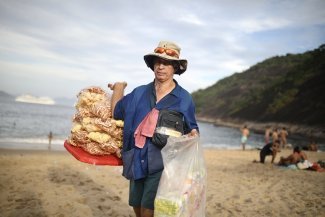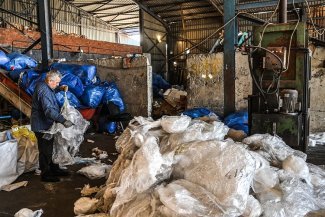
Two decades ago, when Pramila Mandal got married in the remote Indian village of Atapur in West Bengal, agriculture was considered men’s work. But ten years ago, the now 43-year-old wife and mother of two teenage sons dared to follow “the call of Mother Earth, cultivating heirloom rice as a solution to climate and economic adversities.
“Agriculture is becoming more and more uncertain,” says Pramila, explaining why she decided to cultivate indigenous paddy (paddy is rice in the husk, before it is milled). “There is flooding due to excess rain some years, followed by drought in the next. We are facing crop failures and thus losing our food security,” she says, adding that the soil and water in her village has been degraded by years of chemical inputs.
For centuries rice has been an intrinsic part of India’s world-famous gastronomic culture. As well as being one of the country’s leading food crops, India is also one of the biggest rice exporters globally. For decades conventional, mechanised rice farming has been dominated by expensive chemical fertilisers, seeds and other agricultural outputs produced by agribusinesses focused on high yields.
Now, an increasing number of small-scale farmers are turning to hardy folk rice varieties (FRVs), to which there are numerous benefits: they don’t need expensive chemical fertilisers or pesticides to grow; adapted over centuries to local microclimates, they can withstand the vagaries of pests, diseases and droughts; and indigenous seeds can be preserved for longer than modern genetically-modified varieties, which need to be purchased every year. In a country where 70 per cent of the population are involved in agriculture either directly or indirectly, the ever-increasing cost of farming inputs and fuel, coupled with ever-more erratic weather patterns, are driving many farmers to economic ruin, and there are high levels of suicide in some areas of the country.
The less reliant farmers are on agribusiness for inputs, and the more resilient the seeds they plant are, the better for the livelihoods of India’s farmers.
Coming from a family of traditional farmers, paddy cultivation runs in Pramila’s blood. Encouraged by relatives, non-profits organisations and seed conservationists in West Bengal – where most India’s rice is grown – she first began collecting native paddy seeds in 2009 under her own initiative. Today she grows seven varieties of indigenous rice on her 0.49 acres of family land. “Dudheswar, Talmugur, Ashfal, Pakhi…” she says rattling off the names while pointing to the corresponding red, black, brown and deep purple saplings she has planted.
Research suggests that there were once as many as 82,000 varieties of folk rice in India and 5,500 in West Bengal. Following the Green Revolution of the late 1960s, where Indian agriculture underwent dramatic industrialisation, these days there are an estimated 1,500 varieties of folk rice varieties available across the country, with approximately 400 in West Bengal. Unfortunately, most of the lost varieties are unlikely to ever be retrieved.
Farmers who turned to higher-yielding and more profitable varieties of rice (such as Basmati) all but abandoned heirloom rice, except in some cases for personal consumption. But now, with increasing concerns about food security, environmental sustainability and nutritional value, FRVs are making a comeback.
Nutritionally, economically and environmentally better
“It all began with the thought of feeding our children and family with chemical-free, nutritious food,” says 36-year-old Aparna Das, one of a group of 40 women farmers who Pramila has been working with for the last eight years in order to share her wisdom and knowledge. The women work together as an informal collective, without external funding, and have cultivated 16 varieties of native rice, pooling together 49 acres of land.
Souren Chatterjee, another small-scale rice farmer from West Bengal, says that as well as significantly reducing his expenses, folk rice also tastes better. “The grains are long, slender and delicious when cooked,” he tells Equal Times. “The use of natural manures [as fertiliser] enables the rice to retain its typical flavour and characteristics.” Folk rice varieties also tend to be more nutritionally dense than modern hybrids, and are endowed with various micro-nutrients, antioxidants and low glycaemic index values, which is important in India where more than 50 million people have type-2 diabetes.
Tapan Adhikary, a 62-year-old farmer from Khoragari village from West Bengal’s Hooghly district, runs the Agrani (or ‘Progressive’) Farmers’ Club which brings together 100 agriculturists who are all passionate about the natural cultivation of FRVs. Like most folk farmers, they collect seeds, not only to store carefully and use again the following season, but also to exchange and help catalogue the various types available. As well as supporting a self-sustaining rural economy, Adhikary’s primary motivation is environmental: “Since these varieties respond to natural manure, it is a pleasure to watch them grow and bring the surrounding soil and ecosystem back to life with insects, birds and butterflies,” he says.
However, it is a challenge to rejuvenate ‘dead’ soil that has lost its natural biological activities due to the overuse of chemical fertilisers and pesticides. It can, however, be done by growing certain plants, which absorb high levels of nitrogen which are then released into the soil when they decay.
In order to replenish the soil, Adhikary says the farmers use organic methods (which involves external inputs of organic fertilisers and manures) to enable the soil to recover from the harmful impacts of chemical farming. However, the ultimate goal of the Agrani farmers is natural farming, the so-called ‘do nothing’ method, which requires no external inputs and aims to mimic nature as closely as possible. “Natural farming is thus the natural transition from organic cultivation and our ultimate aim,” says Adhikary, although it can take up to six years to get the soil ready.
“The science behind the traditional wisdom of these farmers is commendable,” says Dr Anupam Paul, an assistant director at the Agriculture Training Centre (ATC) in Fulia, which, under the government of West Bengal, has been conserving, studying, trialling and distributing FRVs for the last 13 years. To date, it is the only government-supported initiative across the whole of India that supports the revival of indigenous paddy.
From the farm to the table
Since 2006, Paul has been working with rice farmers across the state to revive the indigenous paddy tradition through his own work at ATC-Fulia’s Biodiversity Conservation Farm. He says that more than 5,000 farmers from 16 of West Bengal’s 23 districts have taken up FRV cultivation, with 150 varieties of indigenous rice covering more than 118,185 hectares of land.
As hosts of the state’s first natural farm, ATC has conserved more than 400 FRVs in a three-acre trial plot. It also runs demonstration centres throughout the state, provides rubber huller machines to farmers for the processing of brown rice, and it currently supports more than 26 FRV seed saver groups in the state, by distributing seeds and providing technical advice. Such groups, comprising small marginalised farmers, are actively involved in the conservation, cultivation and exchange of indigenous paddy seeds, thus motivating other cultivators around them and elsewhere in the country.
A lack of awareness about FRVs still makes the uptake a challenge but farm-to-table web stores such as Amar Khamar (My Farm) offer smart digital solutions.
The brainchild of 45-year-old Kolkata-based entrepreneur Sujay Chatterjee, the website – which sells organic produce directly from local farmers – was officially launched early this year. “The idea was to enable farmers to have direct access to markets and consumers, with a consistent supply of produce to help them fetch the right price,” he tells Equal Times. As many as 300 farmers from across eight districts in West Bengal have registered with the portal, providing consumers with a range of 18-20 FRVs, in addition to pulses, honey and spices.
Chasi Ghar (Farmer’s Home) is run by the Forum for Indigenous Agricultural Movement in the Uttar Dinajpur district of West Bengal. It has more than 100 rice growers who sell their products directly through the market’s WhatsApp group. And in the heart of the state’s capital of Kolkata is Narayani Organics, which brings together 1,000 farmers from West Bengal and further afield. Launched in September 2018, the outlet sells FRVs along with organically grown products as pulses and spices. It also organises meetings and workshops for farmers, experts and non-profits to exchange ideas and skills. “Apart from business, our objective is also to bring together marginalised farmers from across the country to boost organic farming for better health and environment,” say Moumita and Chandan Mukherjee, the duo behind Narayani Organics.








